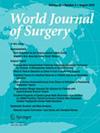Parastomal hernia after ileal conduit: Incidence, natural history and risk factors.
IF 2.3
3区 医学
Q2 SURGERY
引用次数: 0
Abstract
INTRODUCTION Parastomal hernias are a challenging complication of digestive ostomies. Ileal-conduit parastomal hernias after cystectomy have specific aspects. The aim of this study was to describe the incidence and natural history of ileal-conduit parastomal hernias in order to guide their management, as well as to identify risk factors to prevent them. PATIENTS AND METHODS All consecutive patients undergoing cystectomy with a Bricker's ileal conduit in 3 academic centers were retrospectively identified. Data were collected regarding their medical history prior to cystectomy, the operation, the postoperative period, imaging results within 5 years of follow-up, and the onset and timing of clinically or radiologically diagnosed ICPH. RESULTS Among 577 patients included in the study, 115 (20.6%) developed an ICPH during the study period. Most patients did not present any symptom and the diagnosis was made at imaging in 74.8% of them. Most hernias were detected between 1 and 2 years after the cystectomy, with a mean time to diagnosis of 12.4 months. At multivariate analysis, overweight and obesity were independent risk factors for developing an ICPH (adjusted hazard ratio [aHR] 1.96; p = 0.046), while a trans-rectus position of the ostomy was a significant protective factor (aHR 0.45; p = 0.011). CONCLUSIONS A PH develops in almost 20% of patients after ileal conduit urinary diversion, with a mean time of onset of 12.4 months. It is often a subclinical condition detected at medical imaging. Obesity increases the risk, while passing the ileal-conduit through the rectus muscle can help to prevent it.回肠导管术后的吻合口旁疝:发病率、自然史和风险因素。
导言 胃旁疝是消化道造口的一种棘手并发症。膀胱切除术后回肠导管旁疝有其特殊性。本研究旨在描述回肠导管旁疝的发病率和自然史,以指导其治疗,并确定预防其发生的风险因素。患者和方法回顾性地确定了在 3 个学术中心接受膀胱切除术并使用布里克回肠导管的所有连续患者。结果在纳入研究的 577 例患者中,有 115 例(20.6%)在研究期间出现了 ICPH。大多数患者没有任何症状,74.8%的患者是在影像学检查中确诊的。大多数疝气是在膀胱切除术后 1 到 2 年间发现的,平均诊断时间为 12.4 个月。在多变量分析中,超重和肥胖是罹患 ICPH 的独立风险因素(调整后危险比 [aHR] 1.96;p = 0.046),而造口位置为经直肠则是一个重要的保护因素(aHR 0.45;p = 0.011)。它通常是在医学影像检查中发现的亚临床症状。肥胖会增加患病风险,而将回肠导尿管穿过直肠肌则有助于预防这种疾病。
本文章由计算机程序翻译,如有差异,请以英文原文为准。
求助全文
约1分钟内获得全文
求助全文
来源期刊

World Journal of Surgery
医学-外科
CiteScore
5.10
自引率
3.80%
发文量
460
审稿时长
3 months
期刊介绍:
World Journal of Surgery is the official publication of the International Society of Surgery/Societe Internationale de Chirurgie (iss-sic.com). Under the editorship of Dr. Julie Ann Sosa, World Journal of Surgery provides an in-depth, international forum for the most authoritative information on major clinical problems in the fields of clinical and experimental surgery, surgical education, and socioeconomic aspects of surgical care. Contributions are reviewed and selected by a group of distinguished surgeons from across the world who make up the Editorial Board.
 求助内容:
求助内容: 应助结果提醒方式:
应助结果提醒方式:


